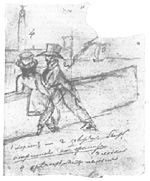- Palace Embankment
-
Coordinates: 59°56′28″N 30°18′45″E / 59.941232°N 30.312629°E
 The Palace Quay, as seen from the Peter and Paul Fortress
The Palace Quay, as seen from the Peter and Paul Fortress
The Palace Embankment or Palace Quay (Russian: Дворцовая набережная, Dvortsovaya Naberezhnaya) is a street along the Neva River in Central Saint Petersburg which contains the complex of the Hermitage Museum buildings (including the Winter Palace), the Hermitage Theatre, the Marble Palace, the New Michael Palace and the Summer Garden.
The street was laid out between 1763 and 1767, when it used to be a preferred place of residence for the Russian Imperial Nobility. The street begins at the Palace Bridge, where the Admiralty Embankment becomes the Palace Embankment, and the street ends at the Fontanka, where it becomes the Kutuzov Embankment.
The Palace Embankment is a very popular street among tourists, as it has a wonderful view of the Neva, the Peter and Paul Fortress and Vasilievsky Island. Many sightseeing boats are available for hire there.
Pushkin associations
In his novel Eugene Onegin, Alexander Pushkin depicted himself walking along Palace Quay with his hero, Eugene Onegin:
Filled with his heart's regrets, and leaning
Against the rampart's granite shelf,
Eugene stood lost in pensive dreaming
(As once some poet drew himself).
The night grew still... with silence falling;
Only the sound of sentries calling,
Or suddenly from Million Street
Some distant droshky's rumbling beat;
Or floating on a drowsy river,
A lonely boat would sail along,
While far away some rousing song
Or plaintive horn would make us shiver.
But sweeter still, amid such nights,
Are Tasso's octaves' soaring flights.For the first edition of this chapter, the poet commissioned an illustration depicting him and Onegin walking together along the quay. Upon receiving the illustration, which represented him leaning on a parapet with his back turned towards the Peter and Paul Fortress, he was exceedingly displeased with the result (which had little in common with his own preliminary sketch, illustrated to the right) and scribbled the following epigram underneath:
Here, after crossing Bridge Kokushkin,
With bottom on the granite propped,
Stands Aleksandr Sergeich Pushkin;
Near M'sieur Onegin he has stopped.
Ignoring with a look superior
The fateful Power's citadel,
On it he turns a proud posterior:
My dear chap, poison not the well!(translated by Vladimir Nabokov)
References
Categories:- Streets in Saint Petersburg
- Art gallery places
- 1763 establishments
- Hermitage Museum
Wikimedia Foundation. 2010.

